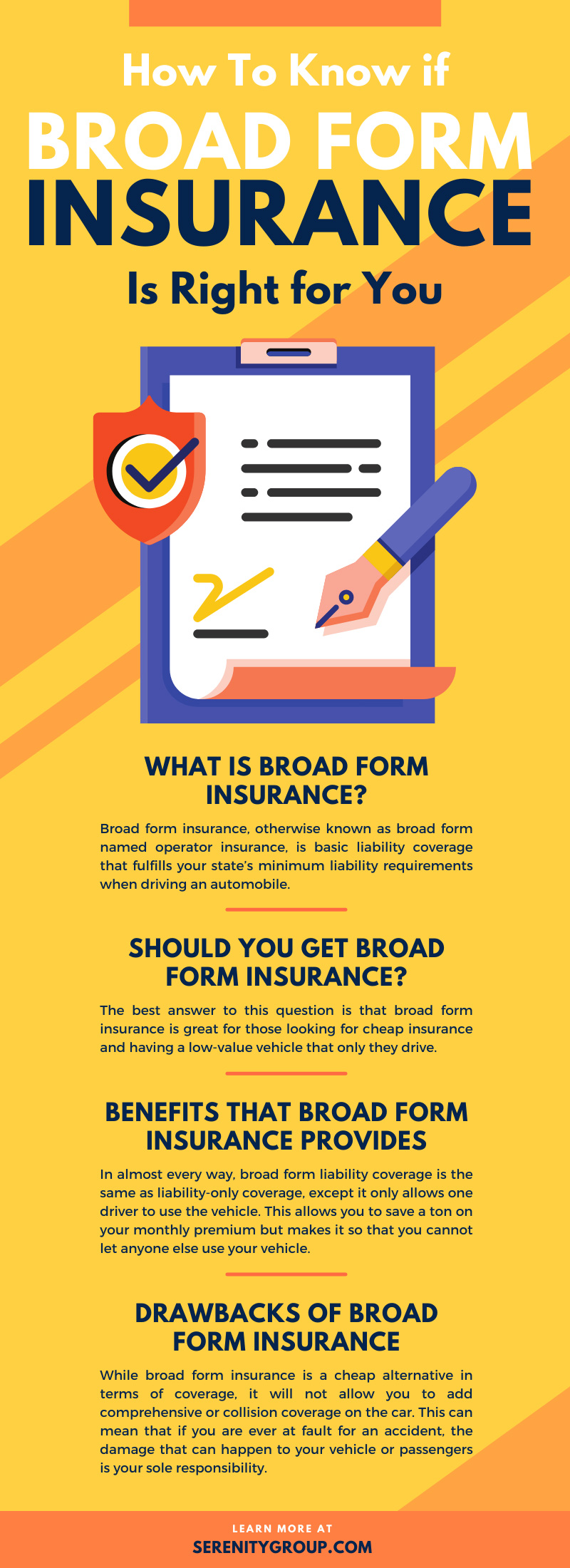How To Know if Broad Form Insurance Is Right for You

Auto insurance is often a gray area of knowledge for most, but it is hardest for those just entering the world of auto ownership. Rates, coverage plans, and insurance providers change every year in a never-ending loop of confusion. Some insurance dealers may even make it harder to understand what you need to get you to overpay on your insurance bill. To counter this, a careful and specific explanation is needed to inform the different insurance types and who they can benefit the most.
This article will cover:
- What broad form insurance is
- Who it is best suited for
- What benefits it provides
- Whether or not it is cheaper
- What the drawbacks are
By the end of this article, you will know whether or not broad form insurance is right for you and the various benefits and drawbacks that it provides.
What Is Broad Form Insurance?
When it comes to insurance, many are unclear on the different types of insurances that exist. Most know about insurance relating to the vehicle it’s covering, but less know about the other types of auto insurance for cars that are available. Broad form insurance, otherwise known as broad form named operator insurance, is basic liability coverage that fulfills your state’s minimum liability requirements when driving an automobile.
This policy only covers the driver’s liability costs. Because of this, broad form insurance will most likely appeal to people who want to pay as little for car insurance as possible (we’ll discuss this in greater detail later).
What Does Broad Form Auto Insurance Cover?
As stated before, broad form insurance is one of the least expensive ways to obtain liability coverage, allowing you to have car insurance. However, broad form insurance differs from a regular insurance policy in one important way. Unlike most types of liability coverage that allow you to add multiple drivers to a single policy, broad form coverage will only cover one licensed driver on the policy.
This type of policy will always exclude any driver from operating your vehicle who is not the named driver on the policy. Because of this, this policy is best for those who do not plan to let others use their car.
It is important to include that if you own or drive multiple cars, you will not have to pay for any additional vehicles that you may own.
Should You Get Broad Form Insurance?
When deciding whether you should get broad form insurance, there are a few key factors that you can use to gain vantage over your situation. These factors include:
- What the benefits of choosing broad form insurance over another type of coverage are
- What the possible limitations to broad form insurance are
- If broad form coverage is the most cost-effective insurance policy for you
However, the best answer to this question is that broad form insurance is great for those looking for cheap insurance and having a low-value vehicle that only they drive.
Benefits That Broad Form Insurance Provides
In almost every way, broad form liability coverage is the same as liability-only coverage, except it only allows one driver to use the vehicle. This allows you to save a ton on your monthly premium but makes it so that you cannot let anyone else use your vehicle.
If nobody else is going to drive your vehicle, there is no reason to have coverage for any additional drivers. As well, providing coverage for additional drivers when there are none can get pricey fast. Some of the main factors that make this type of coverage ideal for drivers are if:
- They are seeking a basic, cheap coverage
- Drive alone often
- Do not have children or dependents
- Own an inexpensive vehicle
- Do not own a car
How Much Cheaper Is Broad Form Insurance?
In most situations, drivers can save quite a bit of money per year on average if they choose broad form insurance over full coverage policies. Of course, this is an average and can vary from person to person and state to state. Because standard policies have comprehensive and collision coverage and higher liability limits, you can expect that the cost of them is much higher. Since the coverage ceiling is not as high, there is some risk involved in driving with broad form insurance. However, one must keep in mind that most people use this sort of insurance policy on less expensive cars.
Drawbacks of Broad Form Insurance
While broad form insurance is a cheap alternative in terms of coverage, it will not allow you to add comprehensive or collision coverage on the car.
This can mean that if you are ever at fault for an accident, the damage that can happen to your vehicle or passengers is your sole responsibility. To add to this, if you end up having to total your car, you will not receive any type of payment from your insurer. So, you are on your own for these costs.
Even so, broad form insurance will still allow all drivers to purchase personal injury protection coverage. This will cover certain medical expenses if you find yourself involved in an accident.
Lastly, it is important to realize that broad form insurance does not cover company-owned vehicles, RVs, or motorcycles (although some states offer this type of insurance specifically for motorcycles). As such, you can only use this insurance for cars.
When deciding whether or not broad form insurance is right for you, it is important to account for your living situation and whether you can realistically keep others from having access to your vehicle. While broad form insurance is an important aspect of vehicle ownership, there are still other types of insurance, such as SR22 broad form insurance, that may be more applicable to your situation. Our knowledgeable staff will help you find a policy perfect for you at a great price! If you find yourself needing help on any matter relating to auto insurance, reach out to Serenity Group.


Recent Comments